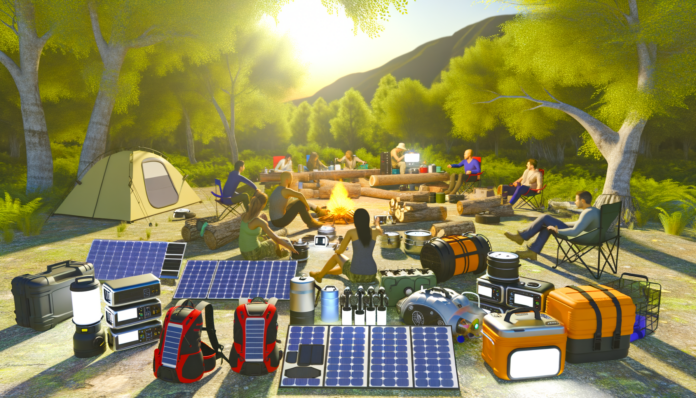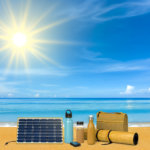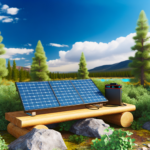Introduction to Solar-Powered Gear
The Rise of Solar Technology in Outdoor Activities
In today’s world, where sustainability and environmental consciousness are at the forefront of our minds, solar-powered gadgets have emerged as a game-changer for outdoor enthusiasts. The concept of utilizing solar power dates back centuries, with ancient civilizations using magnifying glasses to harness sunlight for fire starting. However, it wasn’t until the 19th century that the photovoltaic effect, which is the basis of solar energy conversion, was discovered. Since then, advancements in technology have enabled solar power to become more accessible and efficient, leading to its integration into various sectors, including outdoor gear and gadgets.
Benefits of Solar-Powered Gear for Outdoor Enthusiasts
Solar-powered gear offers numerous advantages for those who enjoy spending time in nature. Here are some key benefits:
- Energy Independence and Sustainability: Solar-powered gadgets provide outdoor enthusiasts the freedom to generate their own energy, eliminating the need for traditional power sources. This independence allows adventurers to explore remote locations without relying on electricity grids or fuel-based generators. Additionally, using clean, renewable energy sources significantly reduces their carbon footprint, contributing to a more sustainable planet.
- Cost-Effectiveness and Long-Term Savings: While investing in solar-powered gadgets may require an initial upfront cost, it can lead to substantial savings in the long run. By harnessing the sun’s energy, outdoor enthusiasts can eliminate the need to purchase disposable batteries or fuel for generators, making solar-powered gadgets a practical choice for frequent outdoor activities.
- Eco-Friendly and Reduced Carbon Footprint: Solar power is a clean and renewable energy source, making solar-powered gadgets an eco-friendly alternative to traditional gadgets. By choosing solar-powered options, outdoor enthusiasts can contribute to the reduction of greenhouse gas emissions and combat climate change. Using solar energy for outdoor adventures aligns with the principles of Leave No Trace and promotes responsible outdoor recreation.
Purpose and Scope of the Article
This article aims to delve into the world of solar-powered gear, exploring the latest innovations and their benefits for outdoor enthusiasts. We will cover various types of solar-powered gadgets, key features to consider when choosing them, and the latest advancements in solar technology. Additionally, we will provide practical tips for using solar-powered gear, share real-life case studies and user experiences, and discuss the future outlook of solar-powered gadgets in the outdoor industry. By the end of this article, readers will have a comprehensive understanding of how solar-powered gear can enhance their outdoor experiences while promoting sustainability.
Types of Solar-Powered Gear
Solar-Powered Chargers and Power Banks
Solar-powered chargers and power banks are essential for outdoor enthusiasts who rely on electronic devices such as smartphones, GPS units, and cameras. These devices harness solar energy to recharge batteries, ensuring that users remain connected even in remote locations. **Portable solar chargers** are typically lightweight and foldable, making them easy to carry during hikes or camping trips. **Power banks** with built-in solar panels can store energy for later use, providing a reliable backup power source. Some advanced models even feature multiple USB ports and wireless charging capabilities, allowing users to charge several devices simultaneously.
Solar-Powered Lighting Solutions
Lighting is crucial for safety and convenience during outdoor activities, and solar-powered lighting solutions offer a sustainable alternative to traditional battery-operated lights. **Solar-powered camping lanterns** and **flashlights** are popular choices, as they can be charged during the day and provide illumination at night. These devices often come with multiple brightness settings and long battery life, ensuring that campers have a reliable light source throughout their trip. Additionally, **solar string lights** can be used to create a cozy ambiance around the campsite, enhancing the overall outdoor experience.
Solar-Powered Cooking and Heating Devices
For those venturing into areas with limited access to traditional cooking facilities, solar-powered cooking and heating devices are invaluable. **Solar ovens** and **cookers** use reflective panels to concentrate sunlight and generate heat, allowing users to cook meals without the need for fuel. These devices are not only eco-friendly but also eliminate the need to carry heavy fuel canisters. **Solar-powered water heaters** can provide hot water for cooking, cleaning, and bathing, making them a versatile addition to any outdoor gear collection. These innovations ensure that outdoor enthusiasts can enjoy hot meals and warm water even in the most remote locations.
Solar-Powered Communication and Navigation Tools
Staying connected and navigating effectively are critical aspects of any outdoor adventure. **Solar-powered communication devices**, such as satellite phones and two-way radios, ensure that users can maintain contact with the outside world, even in areas with no cellular coverage. **Solar-powered GPS units** and **navigation tools** provide accurate location tracking and route planning, helping adventurers stay on course. Some advanced models integrate with smartphones and other smart devices, offering real-time updates and enhanced functionality. These tools are particularly useful for long expeditions and emergency situations, providing peace of mind and safety for outdoor enthusiasts.
Key Features to Look for in Solar-Powered Gear
When selecting solar-powered gear for your outdoor adventures, it’s essential to consider several key features to ensure you get the most out of your investment. Here are the primary factors to keep in mind:
Portability and Weight
One of the most critical aspects of any outdoor gear is its portability. **Lightweight and compact** solar-powered devices are easier to carry, especially during long hikes or camping trips. Look for gear that can be easily packed into your backpack without adding significant weight. Foldable solar panels and compact power banks are excellent choices for maximizing portability without compromising on functionality.
Durability and Weather Resistance
Outdoor environments can be harsh, with exposure to elements like rain, dust, and extreme temperatures. Therefore, **durability and weather resistance** are crucial features for solar-powered gear. Opt for devices made from robust materials that can withstand rough handling and adverse weather conditions. Look for certifications such as **IP ratings** (e.g., IP67) that indicate resistance to water and dust, ensuring your gear remains functional in various environments.
Efficiency and Charging Speed
The efficiency of solar panels and the charging speed of your devices are vital for ensuring you have reliable power when you need it. **High-efficiency solar panels** convert more sunlight into usable energy, which is particularly important in less-than-ideal weather conditions. Additionally, consider the **charging speed** of the gear. Devices with fast-charging capabilities can save you time and ensure your gadgets are ready for use more quickly. Look for specifications that indicate the wattage and output capacity to gauge performance.
Ease of Use and Maintenance
Solar-powered gear should be user-friendly and require minimal maintenance. **Ease of use** includes straightforward setup processes, intuitive controls, and compatibility with various devices. Maintenance should be simple, with easy-to-clean surfaces and durable components that don’t require frequent repairs. Some advanced models come with **smart technology** that automatically adjusts settings for optimal performance, further enhancing ease of use.
By focusing on these key features—portability and weight, durability and weather resistance, efficiency and charging speed, and ease of use and maintenance—you can select solar-powered gear that will enhance your outdoor experiences and provide reliable, sustainable energy solutions.
Latest Innovations in Solar-Powered Gear
Advancements in Solar Panel Technology
The evolution of solar panel technology has been nothing short of revolutionary. Recent advancements have led to the development of more efficient and compact solar cells, which are now capable of converting sunlight into electricity with greater efficacy. Innovations such as *multi-junction solar cells* and *perovskite solar cells* have significantly increased the efficiency rates, making it possible to generate more power from smaller panels. Additionally, the introduction of *flexible and lightweight solar panels* has made it easier to integrate solar technology into various types of outdoor gear, from backpacks to tents.
Integration with Smart Devices
One of the most exciting trends in solar-powered gear is the seamless integration with smart devices. Modern solar gadgets are now equipped with *Bluetooth* and *Wi-Fi* capabilities, allowing users to monitor and control their devices through smartphone apps. For instance, solar-powered lanterns can be dimmed or brightened via an app, and solar chargers can provide real-time data on energy generation and battery status. This integration not only enhances user convenience but also optimizes the performance of the solar gear, ensuring that outdoor enthusiasts can make the most of their solar-powered devices.
Multi-Functional Solar Gadgets
The market is seeing a surge in multi-functional solar gadgets that combine several utilities into one device. For example, solar-powered backpacks now come with built-in USB ports for charging devices, LED lights for nighttime visibility, and even hydration systems. Similarly, solar cookers are being designed to not only cook food but also purify water and charge small electronics. These multi-functional gadgets are particularly appealing to outdoor enthusiasts who need to minimize the weight and volume of their gear while maximizing functionality.
Sustainable and Eco-Friendly Materials
Sustainability is a key focus in the development of new solar-powered gear. Manufacturers are increasingly using *eco-friendly materials* such as recycled plastics and biodegradable components to produce their products. Additionally, the production processes are being optimized to reduce carbon footprints. For instance, some companies are now using *solar energy* to power their manufacturing facilities, further aligning their operations with the principles of sustainability. This commitment to eco-friendly practices not only benefits the environment but also appeals to the growing number of consumers who prioritize sustainability in their purchasing decisions.
In summary, the latest innovations in solar-powered gear are making outdoor adventures more sustainable, efficient, and convenient. From advanced solar panel technology and smart device integration to multi-functional gadgets and eco-friendly materials, these advancements are setting new standards in the outdoor gear industry. As technology continues to evolve, we can expect even more groundbreaking developments that will further enhance the outdoor experience for enthusiasts around the world.
Practical Tips for Using Solar-Powered Gear
Maximizing Solar Exposure
To get the most out of your solar-powered gear, it’s crucial to maximize solar exposure. Here are some tips to ensure your devices receive optimal sunlight:
- Positioning: Place your solar panels in direct sunlight, avoiding shaded areas. Adjust the angle of the panels to face the sun directly, especially during peak sunlight hours (10 AM to 2 PM).
- Mobility: If possible, use portable solar panels that can be moved throughout the day to follow the sun’s path.
- Elevation: Elevate your panels off the ground to avoid obstructions and to capture more sunlight.
- Cleaning: Keep the surface of your solar panels clean from dust, dirt, and debris to maintain efficiency.
Maintaining and Storing Solar Gear
Proper maintenance and storage of your solar-powered gear can extend its lifespan and ensure reliable performance:
- Regular Cleaning: Wipe down solar panels with a soft cloth and mild detergent to remove any buildup that could block sunlight.
- Inspect for Damage: Regularly check for cracks, loose connections, or other signs of wear and tear. Address any issues promptly to prevent further damage.
- Safe Storage: Store your solar gear in a cool, dry place when not in use. Avoid exposing it to extreme temperatures or moisture, which can degrade the materials.
- Battery Care: For devices with built-in batteries, follow the manufacturer’s guidelines for charging and discharging to maintain battery health.
Troubleshooting Common Issues
Even the best solar-powered gear can encounter problems. Here are some common issues and how to troubleshoot them:
- Low Power Output: Ensure the panels are receiving direct sunlight and are clean. Check for any obstructions or shading that might be affecting performance.
- Slow Charging: Verify that all connections are secure and that the device is compatible with the solar charger. Consider using a higher-capacity solar panel if the current one is insufficient.
- Device Not Charging: Inspect the cables and connectors for any damage. Test the solar panel with another device to determine if the issue lies with the panel or the device.
- Battery Issues: If the built-in battery isn’t holding a charge, it might be time to replace it. Follow the manufacturer’s instructions for battery replacement.
Safety Considerations
Using solar-powered gear safely is paramount to prevent accidents and ensure longevity:
- Avoid Overloading: Do not connect devices that exceed the solar panel’s output capacity. Overloading can damage both the panel and the connected devices.
- Proper Ventilation: Ensure that solar panels and batteries have adequate ventilation to prevent overheating, especially during prolonged use.
- Water Resistance: While many solar-powered devices are designed to be weather-resistant, avoid submerging them in water. Check the IP rating for water and dust resistance.
- Secure Installation: When mounting solar panels, ensure they are securely fastened to prevent them from being dislodged by wind or other environmental factors.
By following these practical tips, you can maximize the efficiency, longevity, and safety of your solar-powered gear, making your outdoor adventures more sustainable and enjoyable.
Case Studies and User Experiences
Real-Life Applications of Solar-Powered Gear
Solar-powered gear has proven to be invaluable for outdoor enthusiasts in various real-life scenarios. For instance, John, an avid backpacker, embarked on a month-long journey through remote mountain ranges. He relied heavily on a solar-powered portable charger to keep his smartphone and GPS device operational, eliminating the need for disposable batteries. Additionally, John used a solar-powered water purifier to ensure access to safe drinking water throughout his trip, showcasing the practicality and reliability of solar-powered gear in remote locations.
Another example is Jane, a camping enthusiast who spent three weeks in national parks. She utilized a solar-powered camping lantern, which provided ample light at her campsite without the need for batteries. Jane also had a solar-powered portable charger, enabling her to keep her camera and other electronic devices powered up, allowing her to capture and share her outdoor experiences seamlessly.
User Testimonials and Reviews
User feedback on solar-powered gear has been overwhelmingly positive, with many outdoor enthusiasts praising the convenience and sustainability these devices offer. Here are a few testimonials:
- Mark T.: “I used a solar-powered backpack on my recent hiking trip, and it was a game-changer. I could charge my phone and camera while on the move, and the built-in solar panels were surprisingly efficient even on cloudy days.”
- Sarah L.: “The solar-powered lantern I bought for camping exceeded my expectations. It provided bright, reliable light all night long, and I didn’t have to worry about carrying extra batteries.”
- David R.: “As someone who loves off-grid adventures, my solar-powered water purifier has been a lifesaver. It’s easy to use and ensures I always have access to clean water, no matter where I am.”
Lessons Learned from Experienced Users
Experienced users of solar-powered gear have shared several valuable lessons that can help others maximize the benefits of these devices:
- Maximize Solar Exposure: Position your solar panels to receive the most sunlight possible. This might mean adjusting the angle or moving the panels throughout the day to follow the sun.
- Plan for Cloudy Days: While modern solar panels are efficient, their performance can still be affected by overcast conditions. Carry a small backup battery or alternative power source just in case.
- Regular Maintenance: Keep your solar panels clean and free of debris to ensure optimal performance. Dust and dirt can significantly reduce their efficiency.
- Understand Your Power Needs: Know the power requirements of your devices and ensure your solar-powered gear can meet those needs. This will help you avoid running out of power unexpectedly.
By incorporating these insights and real-life experiences, outdoor enthusiasts can make the most of their solar-powered gear, ensuring a more sustainable and enjoyable adventure.
Conclusion and Future Outlook
Summary of Key Points
In this article, we have explored the burgeoning world of solar-powered gear for outdoor enthusiasts. We began by discussing the rise of solar technology in outdoor activities and the numerous benefits it offers, such as energy independence, cost-effectiveness, and environmental sustainability. We then delved into the various types of solar-powered gear available, including chargers, lighting solutions, cooking devices, and communication tools. Key features to consider when choosing solar-powered gear were highlighted, such as portability, durability, efficiency, and ease of use. We also examined the latest innovations in solar technology, including advancements in solar panels, integration with smart devices, multi-functional gadgets, and the use of sustainable materials. Practical tips for maximizing the use of solar-powered gear and real-life case studies further illustrated the practical applications and benefits of these devices.
The Future of Solar-Powered Gear
The future of solar-powered gear looks incredibly promising. As technology continues to advance, we can expect even more efficient and compact solar panels, making it easier to integrate solar power into a wider range of outdoor gear. Innovations such as perovskite solar cells, which offer higher efficiency and flexibility, are likely to revolutionize the market. Additionally, the integration of solar technology with smart devices will provide users with more control and customization options, enhancing their outdoor experiences.
Moreover, the trend towards multi-functional solar gadgets will continue to grow, offering outdoor enthusiasts versatile tools that can perform multiple tasks. For instance, a single device might serve as a solar charger, flashlight, and water purifier, reducing the need to carry multiple items. The use of sustainable and eco-friendly materials in the production of solar-powered gear will also become more prevalent, aligning with the growing emphasis on environmental responsibility.
Encouraging Sustainable Outdoor Practices
As we look to the future, it is crucial to encourage sustainable outdoor practices among enthusiasts. Solar-powered gear plays a significant role in this endeavor by reducing reliance on non-renewable energy sources and minimizing the environmental impact of outdoor activities. By choosing solar-powered options, outdoor enthusiasts can contribute to the reduction of greenhouse gas emissions and promote the principles of Leave No Trace.
To further encourage sustainable practices, manufacturers and retailers should focus on educating consumers about the benefits of solar-powered gear and how to use it effectively. This can be achieved through informative content, workshops, and partnerships with outdoor organizations. Additionally, offering incentives such as discounts or rebates for purchasing eco-friendly gear can motivate more people to make the switch.
In conclusion, the integration of solar power into outdoor gear is not just a trend but a significant step towards a more sustainable future. As technology continues to evolve, solar-powered gear will become even more efficient, versatile, and accessible, making it an indispensable part of every outdoor enthusiast’s toolkit. By embracing these innovations and promoting sustainable practices, we can ensure that our love for the great outdoors does not come at the expense of the environment.






